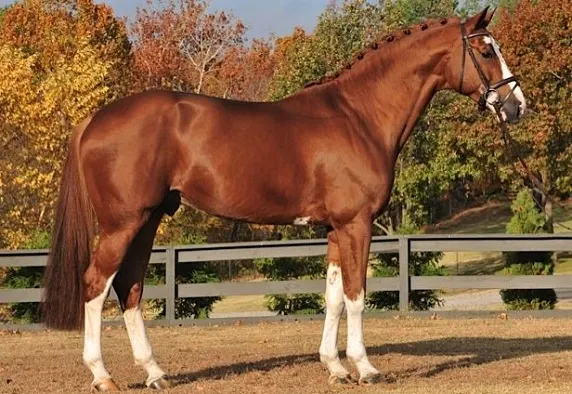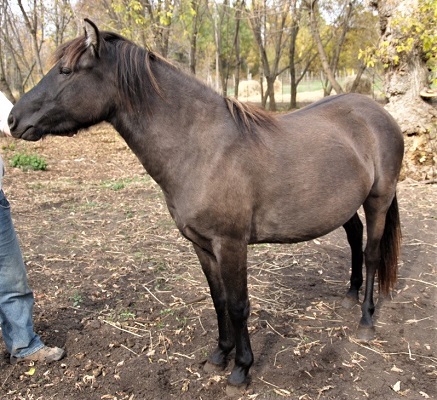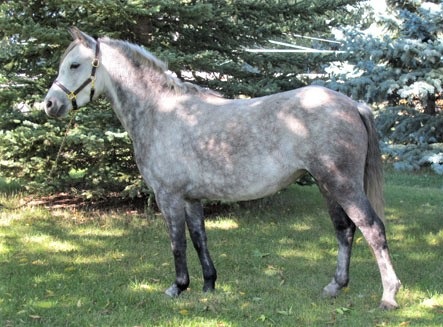
Canada is a vast country, home to busy cities, fierce wildlife, and beautiful, formidable landscapes. The Great White North is also home to some incredible horse breeds.
The Canadian horse breeds are the Newfoundland Pony, Canadian Horse, Sable Island Horse, Lac La Croix Indian Pony, and Canadian Rustic Pony. Canada is also home to two Warmblood registries, the Candian Warmblood and the Canadian Sport Horse.
Horses have a long history in Canada and these breeds have played an important role in the country’s development.
Though most of these breeds are considered rare, there are dedicated owners and breeders working to preserve these wonderful horses.
Here are the seven Canadian horse breeds:
1. Newfoundland Pony

The Newfoundland Pony was developed in the Newfoundland and Labrador providences of Canada over the centuries. These hardy, muscular ponies have adapted to the harsh climates of the islands of the North Atlantic.
The Newfoundland breed originated from British, Scottish, and Irish pony breeds brought over by settlers. Such breeds include the Dartmoor, Exmoor, Connemara, Highland, and Galloway ponies.
Isolated from the rest of the world, these breeds crossbred with each other for hundreds of years, creating the Newfoundland Pony.
Newfoundland ponies stand between 11 to 14.2 hands tall, weighing between 500 to 800 pounds. They have a muscular build, small head, a structure that ranges from fine-boned types to larger stocky types, and a thick mane and tail. Newfoundland ponies are generally bay, black, brown, chestnut, dun, grey, roan, or white in color.
Newfoundland ponies used to freely roam around Newfoundland and were used for plowing gardens, hauling fishing nets, and transporting kelp and wood. Their numbers were once in the thousands until anti-roaming animal by-laws and slaughtering ponies for meat drastically dropped their numbers.
Today, the Newfoundland Pony Society works to preserve this historic breed and they have become reliable choices for riding and driving ponies.
2. Canadian Horse

As the official animal of Canada, the Canadian horse holds a lot of significance to the country. Nicknamed the “little iron horse” the breed is famous for excelling at any task they are given.
The Canadian horse traces back to French horses imported to Quebec from King Louis XIV’s ships between 1665 and 1670.
Though the exact origins of all the horses are unclear, they likely included Bretons, Normans, Arabians, Andalusians and Barbs. The horses were leased to farmers or gentlemen of the country for money or in exchange for a foal, remaining the king’s property for three years.
The breed continued to grow and became popular throughout Canada and in the northern United States. The Canadian horse played influential roles in American breeds including the Morgan, American Saddlebred, and Standardbred.
Many Canadian horses were imported to America for use in the Civil War, resulting in a large drop in numbers.
Canadian horses stand between 14 to 16.2 hands tall, weighing between 1,000 to 1,300 pounds. They have a solid, well-muscled build with a well-arched, graceful neck and a sturdy body. Canadian horses are most commonly bay, black, or chestnut.
During their peak popularity, Canadian horses were categorized into three types: the Canadian Heavy Draft or St. Lawrence, the Frencher, and the Canadian Pacer. However, these categories no longer exist as their remaining stock was incorporated back into the breed.
Today, Canadian horses are popular for riding and driving, excelling in many disciplines.
3. Canadian Warmblood

The Canadian Warmblood was created by combining European Warmbloods with New World vitality. From the combination of Canada’s wide-open pastures and harsh winter climate, Canadian Warmbloods have become hardy, tough and strong-boned.
Canadian Warmbloods excel at dressage, eventing, and showjumping. They are suitable for riders of all levels, from beginners all the way to the Olympic level. These athletic horses are known for their good temperaments and willingness to please.
Canadian Warmbloods generally stand between 15 to 17 hands tall, weighing around 1,000 to 1,300 pounds. They have medium-sized builds with athletic bodies with good muscling, with the registry accepting various types.
Canadian Warmbloods come in a variety of colors including bay, chestnut, and gray.
4. Sable Island Horse

The Sable Island horse is a small feral breed of horse found on Sable Island off the coast of Nova Scotia. Wild and free, they are federally protected and the herd lives unmanaged.
Though legends say that the horses swam to the island after a shipwreck, there is no historical evidence to support this theory. Instead, the horses were actually intentionally brought over in the 18th century. The first recorded horses were brought over by a Boston clergyman, Reverend Andrew Le Mercier.
The Sable Island horses are believed to be descended mainly from horses taken by the British during the Expulsion of the Acadians. The Acadian horses included Breton, Andalusian, and Norman breeds, later crossed with horses from New England.
During the 19th century, other breeding stock, including Thoroughbred, Morgan, and Clydesdale blood, were sent to the island to improve the breeding stock.
Throughout the 19th and 20th centuries, the Sable Island horses were regularly rounded up and transported to the mainland. On the mainland they were often sold for slaughter. However, in 1960 the Canadian government protected the horses in their feral state.
Sable Island horses stand between 13 to 14 hands tall, weighing between 700 to 900 pounds. They have stocky, short builds with arched necks and shaggy coats, coming in a variety of colors. Though they are often pony-sized, they have a horse phenotype with horse ancestors.
5. Lac La Croix Indian Pony

OLYMPUS DIGITAL CAMERA
The Lac La Croix Indian pony, also known as the Ojibwa, is a semi-feral horse breed developed by the Lac La Croix First Nation. This special breed has a long-standing spiritual relationship with the indigenous people of Canada.
The history of the Lac La Croix Indian pony and the Lac La Croix people goes back hundreds of years. In fact, some believe the breed goes back to before Europeans brought horses to America.
The Ojibwa people used them to haul wood and pull ice blocks. Then in spring and summer, the ponies were given time off to roam freely.
Though they used to be abundant, in 1977 only four mares remained. In order to save the breed, Spanish Mustangs were introduced to the bloodlines. Though still rare, they are used in therapeutic programs and to promote indigenous heritage.
The Lac La Croix Indian Pony stands between 12 to 14.2 hands tall, weighing around 700 to 900 pounds. They have a strong, sturdy build with durable feet and legs and excellent stamina.
Lac La Croix Indian ponies come in every solid color but white or cream dilutions, often exhibiting primitive markings.
Also read: 12 Best Places to See Wild Horses in North America
6. Canadian Rustic Pony

Originating in the provinces of Saskatchewan and Manitoba, the Canadian Rustic pony is a relatively new breed. The breed was first developed by Dr. Peter Neufeld of Manitoba, Canada, with the Canadian Rustic Pony Association forming in 1989.
The Canadian Rustic pony was created by breeding Arabians, Welsh ponies, and Heck horses. Heck horses, which resemble the now-extinct Tarpan, were selected from the Atlanta Zoo for breeding. Though they are relatively rare, they are great family horses, excelling in both riding and driving.
Canadian Rustic ponies stand between 12.2 to 13.2 hands tall, weighing around 700 to 800 pounds. They have a slightly dished facial profile, thick but arching neck, and a sturdy body. Canadian Rustic ponies can be gray, buckskin, dun, or bay, exhibiting primitive markings and having partially raised manes.
7. Canadian Sport Horse

Another warmblood registry, the Canadian Sport horse is an evolving breed. The goal is to produce a horse that can successfully compete in dressage, hunter, eventing, and jumper disciplines.
Originally the Canadian Hunter and Light Horse Improvement Society, it became the Canadian Sport Horse Association (CSHA) in the mid-1980s. It is Canada’s oldest indigenous sport horse breed registry. In addition, the CSHA is the first open studbook in North America to include European warmbloods in its pedigrees.
Canadian Sport horses got their start from farm mares, usually of mixed breeds, crossed with Thoroughbreds. With the increase of European warmbloods in Canada during the 1900s, the CSHA saw it as an opportunity to improve the quality of performance horses.
Canadian Sport horses stand between 16 to 17 hands tall, weighing around 1,100 to 1,300 pounds. They have an athletic build with a well-defined head and a well-set neck. Canadian Sport horses come in a variety of colors including bay, chestnut, and gray.